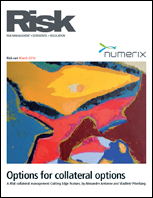
Options for Collateral Options
Download this complimentary research paper, as published in Risk Magazine.
Credit support annexes specify rules for posting collateral. If multiple currencies are allowed, then the party posting collateral has a choice of which currency to post, now and at each future point in time. This choice leads to optionality that needs to be accounted for when valuing even the most basic of derivatives, such as forwards or swaps.
Numerical efficiency for valuing this optionality is key and first-order approximations have been proposed previously. In this paper, for the case of two currencies, Drs. Alexandre Antonov and Vladimir Piterbarg propose more accurate schemes that are still very efficient.
Authors: Dr. Alexandre Antonov, Dr. Vladimir Piterbarg
Credit support annexes specify rules for posting collateral. If multiple currencies are allowed, then the party posting collateral has a choice of which currency to post, now and at each future point in time. This choice leads to optionality that needs to be accounted for when valuing even the most basic of derivatives, such as forwards or swaps.
Numerical efficiency for valuing this optionality is key and first-order approximations have been proposed previously. In this paper, for the case of two currencies, Drs. Alexandre Antonov and Vladimir Piterbarg propose more accurate schemes that are still very efficient.
Authors: Dr. Alexandre Antonov, Dr. Vladimir Piterbarg
Authors

Dr. Vladimir Piterbarg
Dr. Piterbarg is a Managing Director and the Head of Quantitative Analytics at Barclays Capital. Before joining Barclays Capital in March 2005, he was a co-head of quantitative research for Bank of America, where he had worked for 8 years. Vladimir Piterbarg’s main areas of expertise are the modelling of exotic interest rate and hybrid derivatives.
Among his many published papers, Dr. Piterbarg authored "Stochastic volatility model with time-dependent skew," (Applied Mathematical Finance, 12(2): 147-185, June 2005), which introduced stochastic volatility to the LIBOR market model. He was named Quant of the Year 2006 by Risk Magazine, was the Associate Editor of the Journal of Computational Finance, and was Co-Editor (along with Leif B.G. Andersen) of the Interest Rate Modeling section for the Encyclopedia of Quantitative Finance.
Dr. Piterbarg holds a Ph.D. in Mathematics (Stochastic Calculus) from University of Southern California.

Dr. Alexandre Antonov
Dr. Antonov received his PhD degree from the Landau Institute for Theoretical Physics in 1997 and joined Numerix in 1998, where he currently works as a Senior Vice President of Quantitative Research. His activity is concentrated on modeling and numerical methods for interest rates, cross currency, hybrid, credit and CVA. Dr. Antonov is a published author for multiple publications in mathematical finance, including RISK magazine and a frequent speaker at financial conferences.


